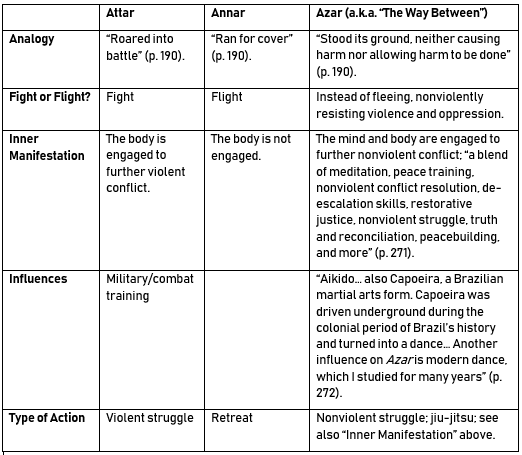Minds of the Movement
An ICNC blog on the people and power of civil resistance
by Amber FrenchApril 17, 2019
The Harry Potter bug never bit me.
Glancing at the back cover of Rivera Sun’s The Way Between (Rising Sun Press Works, 2016) last month, my first thought was “I’m not sure this is my genre.” But I had noticed the novel making its way around my professional circles for some time, so I was curious to see for myself what the buzz was about.
Diving in, I quickly realized that the buzz has been about a highly creative fiction filled with movement and visually stimulating passages that I believe anyone—whether social justice impassioned or not—would enjoy. While some have called it “protest fiction,” I would argue that it’s more “principled fiction.” With its dual focus on nonviolent conflict and ethical nonviolence, it aims to fill the gap that centuries of war- and violence-centered art and literature have left us with. The Way Between goes against the grain.
I was particularly drawn to Sun’s use of movement as an analogy for the important concepts that Ari Ara, the young, fiery red-headed protagonist, discovers. The analogy is not only effective; it gives the narrative an exciting tempo.
Movement, and Situating The Way Between in Conflict Studies
“She did not know that she was moving in ways that even the living Fanten across the valley did not know… She could not see the living humans watch her eyes trace the dances of the ancestors as her body eerily whirled and trembled with the hint of death and transformation, the closing gate of autumn and the opening door of winter… She saw nothing but the ancestor spirit and the eternal movement of the dance.”
As illustrated in the excerpt above, Sun, who trained for many years in modern dance, uses movement (and meditation) to situate concepts in the novel within the field of conflict studies more broadly. As a lifelong dancer myself, this really spoke to me.
I created a table to break this down (see below). It is divided into three concepts—Attar, Annar, and Azar—to which protagonist Ari Ara is exposed while studying under a prominent warrior at Monk’s Head Monastery. These three concepts signify points along the conflict spectrum, which is a useful tool for communicating that oppressed people have an alternative—actually, many alternatives—to “fight or flight” in an asymmetrical conflict against an oppressor.
“The Way Between” in the Broader Conflict Spectrum

From the movement analogy, readers understand that ordinary people of all backgrounds, sizes, and ages can take matters into their own hands in the face of injustice—a concept called “human agency.” Most of the Attar trainees at the monastery are boys, while our petite but agile heroine, Ari Ara, trains in Azar. She not only effectively wields this practice for greater good but also aspires to teach it to others in the kingdom… since when it comes to civil resistance, the more the merrier.
Principled Fiction
As principled fiction, The Way Between trains readers to spot, in a storyline, ordinary people’s agency to affect change—without necessarily making a political statement. This is perhaps even more difficult than the task of writing a fiction fantasy that makes a political statement about society.
Over the years, I’ve had several arguments with friends about whether artists, writers, and other creatives have the responsibility to take a normative stance on some social issue in their work. I side with well-known Chinese dissident artist Ai Weiwei who has emphasized that “Art needs to stand for something,” and it should “cast a critical eye.” But after reading The Way Between, I now also recognize that art and literature can itself resist the dominant narratives that shape our views of history and society—something that can absolutely happen in a political vacuum.
Rivera Sun deserves an international audience and I hope she gets it. Even if social justice (or fantasy, for that matter) isn’t your thing, The Way Between will get you thinking about the world in ways you never did before.

Amber French
Amber French is Senior Editorial Advisor at ICNC, Managing Editor of the Minds of the Movement blog (est. June 2017) and Project Co-Lead of REACT (Research-in-Action) focusing on the power of activist writing. Currently based in Paris, France, she continues to develop thought leadership on civil resistance in French.
Read More